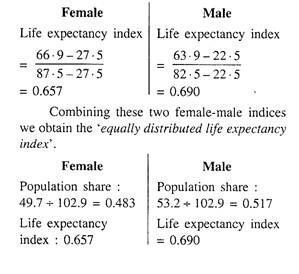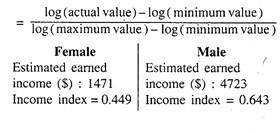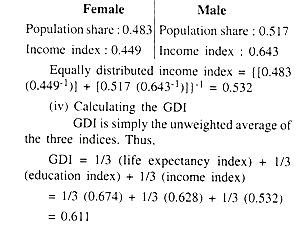Let us make an in-depth study of the subject matter and construction of gender-related development index.
Subject Matter:
According to Amartya Sen, economic development needs to be defined in terms of ‘entitlement’ and ‘capability’. By entitlement we mean a set of alternative commodity bundles that an individual can command through the totality of rights and obligations that one faces.
Thus, entitlement generates ‘capabilities’ that represent a person’s freedom to achieve various functioning combinations.
In other words, capability is essentially one of freedom. And by economic development Sen suggests capability expansion or expansion of freedoms. For instance, poverty is a failure to achieve certain minimum capabilities. Un-freedoms like hunger, malnutrition, poverty, poor health, economic insecurity, poor schooling and health care, etc., generate inequalities. Despite remarkable growth, a vast section of population of the contemporary society is deprived of basic freedoms. One such un-freedom is gender bias.
ADVERTISEMENTS:
Though HDI incorporates some aspects of human development, inequalities in opportunities between men and women are missed out in HDI. Because of gender bias in health care, mortality rates of women are high compared to men. It is the adverse sex ratio as observed in Asia and North Africa which is attributed to ‘missing women’ concept. Above all, in respect of allocation of health care, schooling, food and nutrition, the neglect of women is rampant. All the.se reflect gender-related inequality.
With the advancement of economic progress as well as social progress, such clear cut bias against women should have declined. Unfortunately, such trend is on the rise. Capability deprivation results in gender inequality. Through sex- selective abortion, female fetuses are eliminated so that no female child is born. In 1998, as a re- suit, for the world as a whole, shortfall of women relative to men exceeded 100 million. This is called ‘missing women’.
The 2012 World Development Report puts this figure to 3.9 million in low income countries. Substantive freedoms that a male member enjoys are denied to female member. For example, women eat less and get little medical attention. Educational gender gap is also perceptible. Women have no or little power or authority over any household decision-making process. Outside the home, women are politically marginalised. All these reflect gender disparity.
To measure the extent of this disparity or inequality, the UNDP in 1995 took a new initiative to construct an index called ‘gender-related development index’ (GDI). In addition, in order to close this gap, women used to be empowered. To measure the extent of empowerment of women, the UNDP devised ‘gender empowerment index’ (GEI) also in 1995.
ADVERTISEMENTS:
The HDI measures achievements in human development in terms of three indicators, but ignores differences between men and women. Gender differentials in achievement are studied with the index called GDI. Like the HDI, GDI measures achievements in the same three dimensions and variables in respect of men and women.
These three dimensions may now be recapitulated:
(i) A long and healthy life, as measured by life expectancy at birth;
ADVERTISEMENTS:
(ii) Knowledge, as measured by the adult literacy rate and the combined primary, secondary and tertiary gross enrolment ratio; and
(iii) Estimated earned income measured by US $ .
Before calculating GDI, an index requires to be created for each of these dimensions.
To calculate these dimension indices, minimum and maximum values for female and male indices in each dimension are calculated in accordance with the following formula:
Dimension index = actual value – minimum value/maximum value – maximum value
The gender disparity, lower the GDI. Countries that have achieved some success in expanding capabilities for both men and women will have higher GDI. A country having a GDI less than 0.500 indicates larger gender disparity.
How GDI is understood has been presented in terms of Fig. 5.2.
How is GDI Constructed?
In HDI, the life expectancy index at birth of a country is calculated. But in the case of GDI, life expectancy at birth for both male and female are calculated. After determining life expectancy at birth for male and female, these are combined in a way that ‘penalises’ differences in achievement between men and women. The index thus obtained is called ‘equally distributed life expectancy index’.
ADVERTISEMENTS:
The formula of this index is:
Equally distributed index = {[female population share (female index 1- ɛ)] + [male population share (male index 1- ɛ)]}
ɛ measures the inequality aversion. In the GDI, ɛ is assumed to be equal to 2. If e = 0 then GDI equals HDI. As e tends to infinity gender inequality widens.
The calculation procedure of GDI involves the following four steps:
(i) Calculating the Equally Distributed Life Index:
ADVERTISEMENTS:
Out of 102.9 crore Indian population in 2001 census, male members (53.2 crore) exceeded female members. Life expectancies at birth for Indian women and men were 66.9 years and 63.9 years. Thus,
The equally distributed life index = ([0.483 (0.657-1)-1 + [0.517 + (0.690-1)])-1= 0.674
(ii) Calculating the Equally Distributed Education Index:
First, the adult literacy rates for women and men are determined. Secondly, the combined primary, secondary and tertiary gross enrolment ratios for women and men are calculated.
ADVERTISEMENTS:
Now we will calculate the education index for both women and men. To do this, two-thirds weight to the adult literacy index and one-third weight to the gross enrolment index are assigned to obtain both female and male education indices.
Education index = 2/3 (adult literacy index) + 1/3 (gross enrolment index)
Female education index = 2/3 (0.537) + 1/3
(0.753) = 0.551
Male education index = 2/3 (0.753) + 1/3 (0.660) = 0.722
ADVERTISEMENTS:
Finally, the female and male education indices are combined to obtain the equally distributed education index:
(iii) Calculating the Equally Distributed Income Index:
Finally, female and male income index (based on PPP US$) is calculated.
Income index is calculated according to the following formula:
Income index
Combining the female and male income indices, we calculate equally distributed income index:






